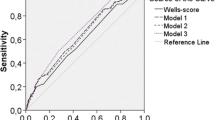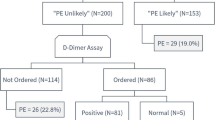Abstract
Purpose
Computed tomography pulmonary angiography (CT-PA) is the diagnostic modality used for pulmonary embolism (PE). This study aimed to estimate the positive CT-PA rate and identify the predictors of positive CT-PA results.
Methods
A retrospective observational study was conducted by examining the CT-PA data for ruling out PE in all adult patients who visited the King Fahd Hospital of Imam Abdulrahman Bin Faisal University. The data regarding background demographic information, clinical information, and CT-PA findings were collected from electronic health records. Data were analyzed descriptively using the chi-squared test. Multivariate regression analysis was used to identify the predictors of positive CT-PA results.
Results
In total, 548 patients (209 male, 339 female) who underwent CT-PA scans were included. The positive CT-PA rate was 18.8%. The Charlson Comorbidity Index was not significantly associated with positive CT-PA results (p = 0.456). Multivariate logistic regression analysis revealed that smoking (odds ratio [OR] 4.96; 95% confidence interval [95% CI] 2.05–12.02) was an independent factor associated with positive CT-PA results. The CT-PA scans performed in winter and spring were 43% (OR 0.43; 95% CI 0.22–0.84) and 52% (OR 0.52; 95% CI 0.28–0.97) less likely to show positive results compared with those performed in autumn, respectively.
Conclusion
The positive CT-PA rate varied significantly between seasons. Smoking was a predictor of positive CT-PA results. These findings may assist in developing interventions for improving the utilization of CT-PA scans to avoid unnecessary exposure of patients to radiation.
Clinical trial registration
N/A

Similar content being viewed by others
References
Horlander KT, Mannino DM, Leeper KV (2003) Pulmonary embolism mortality in the United States, 1979-1998: an analysis using multiple-cause mortality data. Arch Intern Med 163(14):1711–1717. https://doi.org/10.1001/archinte.163.14.1711
Goldhaber SZ, Visani L, De Rosa M (1999) Acute pulmonary embolism: clinical outcomes in the international cooperative pulmonary embolism registry (ICOPER). Lancet 353(9162):1386–1389. https://doi.org/10.1016/s0140-6736(98)07534-5
Wiener RS, Schwartz LM, Woloshin S (2013) When a test is too good: how CT pulmonary angiograms find pulmonary emboli that do not need to be found. BMJ 347:f3368. https://doi.org/10.1136/bmj.f3368
Venkatesh AK, Agha L, Abaluck J, Rothenberg C, Kabrhel C, Raja AS (2018) Trends and variation in the utilization and diagnostic yield of chest imaging for Medicare patients with suspected pulmonary embolism in the emergency department. AJR Am J Roentgenol 210(3):572–577. https://doi.org/10.2214/AJR.17.18586
Moores LK, Jackson WL Jr, Shorr AF, Jackson JL (2004) Meta-analysis: outcomes in patients with suspected pulmonary embolism managed with computed tomographic pulmonary angiography. Ann Intern Med 141(11):866–874. https://doi.org/10.7326/0003-4819-141-11-200412070-00011
Deblois S, Chartrand-Lefebvre C, Toporowicz K, Chen Z, Lepanto L (2018) Interventions to reduce the overuse of imaging for pulmonary embolism: a systematic review. J Hosp Med 13(1):52–61. https://doi.org/10.12788/jhm.2902
Dhakal P, Iftikhar MH, Wang L, Atti V, Panthi S, Ling X, Mujer MTP, Dawani O, Rai MP, Tatineni S, Shrotriya S, Rayamajhi S (2019) Overutilisation of imaging studies for diagnosis of pulmonary embolism: are we following the guidelines? Postgrad Med J 95(1126):420–424. https://doi.org/10.1136/postgradmedj-2018-135995
Morales-Borrero WJ, Maldonado-Vargas JA (2016) Diagnostic yield of pulmonary CT angiography in the evaluation of pulmonary embolisms treated at the Puerto Rico Medical Center from 2008 to 2012. P R Health Sci J 35(1):16–19
Soo Hoo GW, Tsai E, Vazirani S, Li Z, Barack BM, Wu CC (2018) Long-term experience with a mandatory clinical decision rule and mandatory d-dimer in the evaluation of suspected pulmonary embolism. J Am Coll Radiol 15(12):1673–1680. https://doi.org/10.1016/j.jacr.2018.04.031
Donohoo JH, Mayo-Smith WW, Pezzullo JA, Egglin TK (2008) Utilization patterns and diagnostic yield of 3421 consecutive multidetector row computed tomography pulmonary angiograms in a busy emergency department. J Comput Assist Tomogr 32(3):421–425. https://doi.org/10.1097/RCT.0b013e31812e6af3
Costantino MM, Randall G, Gosselin M, Brandt M, Spinning K, Vegas CD (2008) CT angiography in the evaluation of acute pulmonary embolus. AJR Am J Roentgenol 191(2):471–474. https://doi.org/10.2214/AJR.07.2552
Richardson S, Lucas E, Cohen SL, Zhang M, Qiu G, Khan S, McGinn T (2020) Predictors of overtesting in pulmonary embolism diagnosis. Acad Radiol 27(3):404–408. https://doi.org/10.1016/j.acra.2019.04.018
Chen YA, Gray BG, Bandiera G, MacKinnon D, Deva DP (2015) Variation in the utilization and positivity rates of CT pulmonary angiography among emergency physicians at a tertiary academic emergency department. Emerg Radiol 22(3):221–229. https://doi.org/10.1007/s10140-014-1265-6
Charlson ME, Pompei P, Ales KL, MacKenzie CR (1987) A new method of classifying prognostic comorbidity in longitudinal studies: development and validation. J Chronic Dis 40(5):373–383. https://doi.org/10.1016/0021-9681(87)90171-8
Quigley A, Brown K (2010) Appropriateness of usage of computed tomography pulmonary angiography (CTPA) investigation of suspected pulmonary embolism. Royal College of Radiologists. https://www.rcr.ac.uk/audit/appropriateness-usage-computed-tomography-pulmonary-angiography-ctpa-investigation-suspected. Accessed 11 May 2020
Chen Z, Deblois S, Toporowicz K, Boldeanu I, Francoeur MO, Sadouni M, Lepanto L, Chartrand-Lefebvre C (2019) Yield of CT pulmonary angiography in the diagnosis of acute pulmonary embolism: short report. BMC Res Notes 12(1):41. https://doi.org/10.1186/s13104-019-4076-8
Al Dandan O, Hassan A, Alnasr A, Al Gadeeb M, AbuAlola H, Alshahwan S, Al Shammari S, Alzaki A (2020) The use of clinical decision rules for pulmonary embolism in the emergency department: a retrospective study. Int J Emerg Med 13:23. https://doi.org/10.1186/s12245-020-00281-1
Tse R, Thompson N, Moscova M, Sindhusake D, Shetty A, Young N (2016) Do delays in radiology lead to breaches in the 4-hour rule? Clin Radiol 71(6):523–531. https://doi.org/10.1016/j.crad.2016.02.008
Li S, Brantley E (2015) Malpractice liability risk and use of diagnostic imaging services: a systematic review of the literature. J Am Coll Radiol 12(12 Pt B):1403–1412. https://doi.org/10.1016/j.jacr.2015.09.015
AlDakhil LO (2016) Obstetric and gynecologic malpractice claims in Saudi Arabia: incidence and cause. J Forensic Legal Med 40:8–11. https://doi.org/10.1016/j.jflm.2016.02.001
Kabrhel C, Camargo CA Jr, Goldhaber SZ (2005) Clinical gestalt and the diagnosis of pulmonary embolism: does experience matter? Chest 127(5):1627–1630. https://doi.org/10.1378/chest.127.5.1627
Buchanan I, Teeples T, Carlson M, Steenblik J, Bledsoe J, Madsen T (2017) Pulmonary embolism testing among emergency department patients who are pulmonary embolism rule-out criteria negative. Acad Emerg Med 24(11):1369–1376. https://doi.org/10.1111/acem.13270
Ministry of Health – Kingdom of Saudi Arabia (2020) Healthcare Transformation Strategy. https://www.moh.gov.sa/en/Ministry/vro/Pages/Health-Transformation-Strategy.aspx. Accessed 11 May 2020
Shah P, Arora S, Kumar V, Sharma S, Shah H, Tripathi B, Sharma P, Sharma R, Savani S, Qureshi MR, Faruqi I (2018) Short-term outcomes of pulmonary embolism: a national perspective. Clin Cardiol 41(9):1214–1224. https://doi.org/10.1002/clc.23048
Mamlouk MD, vanSonnenberg E, Gosalia R, Drachman D, Gridley D, Zamora JG, Casola G, Ornstein S (2010) Pulmonary embolism at CT angiography: implications for appropriateness, cost, and radiation exposure in 2003 patients. Radiology 256(2):625–632
Kindermann DR, McCarthy ML, Ding R, Frohna WJ, Hansen J, Maloy K, Milzman DP, Pines JM (2014) Emergency department variation in utilization and diagnostic yield of advanced radiography in diagnosis of pulmonary embolus. J Emerg Med 46(6):791–799. https://doi.org/10.1016/j.jemermed.2013.12.002
Tsai AW, Cushman M, Rosamond WD, Heckbert SR, Polak JF, Folsom AR (2002) Cardiovascular risk factors and venous thromboembolism incidence: the longitudinal investigation of thromboembolism etiology. Arch Intern Med 162(10):1182–1189. https://doi.org/10.1001/archinte.162.10.1182
Severinsen MT, Kristensen SR, Johnsen SP, Dethlefsen C, Tjonneland A, Overvad K (2009) Smoking and venous thromboembolism: a Danish follow-up study. J Thromb Haemost 7(8):1297–1303. https://doi.org/10.1111/j.1538-7836.2009.03490.x
Goldhaber SZ, Grodstein F, Stampfer MJ, Manson JE, Colditz GA, Speizer FE, Willett WC, Hennekens CH (1997) A prospective study of risk factors for pulmonary embolism in women. JAMA 277(8):642–645
Hansson PO, Eriksson H, Welin L, Svardsudd K, Wilhelmsen L (1999) Smoking and abdominal obesity: risk factors for venous thromboembolism among middle-aged men: “the study of men born in 1913”. Arch Intern Med 159(16):1886–1890. https://doi.org/10.1001/archinte.159.16.1886
Newby DE, Wright RA, Labinjoh C, Ludlam CA, Fox KA, Boon NA, Webb DJ (1999) Endothelial dysfunction, impaired endogenous fibrinolysis, and cigarette smoking: a mechanism for arterial thrombosis and myocardial infarction. Circulation 99(11):1411–1415. https://doi.org/10.1161/01.cir.99.11.1411
Jang MJ, Kim HJ, Bang SM, Lee JO, Yhim HY, Kim YK, Kim YK, Choi WI, Lee EY, Kim IH, Park S, Sohn HJ, Kim DK, Kim M, Oh D (2012) Seasonal variation in the occurrence of venous thromboembolism: a report from the Korean Venous Thromboembolism Working Party. Thromb Res 130(4):e199–e202. https://doi.org/10.1016/j.thromres.2012.07.019
Manfredini R, Imberti D, Gallerani M, Verso M, Pistelli R, Ageno W, Agnelli G (2009) Seasonal variation in the occurrence of venous thromboembolism: data from the MASTER Registry. Clin Appl Thromb Hemost 15(3):309–315. https://doi.org/10.1177/1076029608319947
Dentali F, Ageno W, Rancan E, Donati AV, Galli L, Squizzato A, Venco A, Mannucci PM, Manfredini R (2011) Seasonal and monthly variability in the incidence of venous thromboembolism. A systematic review and a meta-analysis of the literature. Thromb Haemost 106(3):439–447. https://doi.org/10.1160/TH11-02-0116
Zhao H, Li Y, Wu M, Ren W, Ji C, Miao H, Han Y (2020) Seasonal variation in the frequency of venous thromboembolism: an updated result of a meta-analysis and systemic review. Phlebology:268355519897650. https://doi.org/10.1177/0268355519897650
Elias S, Hoffman R, Saharov G, Brenner B, Nadir Y (2016) Dehydration as a possible cause of monthly variation in the incidence of venous thromboembolism. Clin Appl Thromb Hemost 22(6):569–574. https://doi.org/10.1177/1076029616649435
Salehi L, Phalpher P, Ossip M, Meaney C, Valani R, Mercuri M (2020) Variability in practice patterns among emergency physicians in the evaluation of patients with a suspected diagnosis of pulmonary embolism. Emerg Radiol 27(2):127–134. https://doi.org/10.1007/s10140-019-01740-w
Author information
Authors and Affiliations
Corresponding author
Ethics declarations
Conflict of interest
The authors declare that they have no conflict of interest.
Additional information
Publisher’s note
Springer Nature remains neutral with regard to jurisdictional claims in published maps and institutional affiliations.
Rights and permissions
About this article
Cite this article
Alsaif, H.S., Hassan, A., AlSheikh, M. et al. Predictors of positive computed tomography pulmonary angiography results. Emerg Radiol 27, 503–511 (2020). https://doi.org/10.1007/s10140-020-01793-2
Received:
Accepted:
Published:
Issue Date:
DOI: https://doi.org/10.1007/s10140-020-01793-2




